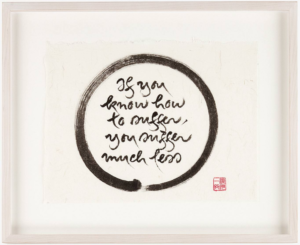Excerpt from Breathe, You Are Alive! by Thich Nhat Hanh. Apple Books.
Read Breathe, You Are Alive! by Thich Nhat Hanh. Parallax Press.
From Chapter 2, in the section on “Looking Deeply in Order to Shed Light on the True Nature of All Dharmas”
We have an idea that we began to exist the day our mother gave us birth and that the day we are buried, we cease to exist. We say we are our body, and outside of our own body, we do not exist.
 “Breathing in, I let go of my idea of my body as myself.”
“Breathing in, I let go of my idea of my body as myself.”
“Breathing out, I let go of my idea that this period of fifty to one hundred years is my life span.”
Anathapindika was a lay disciple who had always given a lot of support to the Buddha and the community of monks. When he was about to pass away and was in great pain, he was given teachings by the Venerable Shariputra to help him let go of ideas of self and life span. These teachings can be found in the Sutra on Teachings to Be Given to the Sick.
After Shariputra guided Anathapindika in a meditation on the Buddha, the Dharma, and the Sangha to nourish the seeds of joy in him, he began to offer the cream of the Buddha’s teachings: “Friend Anathapindika, please meditate like this: ‘These eyes are not me. I am not caught in these eyes.’” He went from eyes to ears, nose, tongue“body, and mind; to form sound, smell, taste, touch, and objects of mind; then to eye-consciousness, up to mind consciousness. “All these things are not me. I have no need to be caught by them.”
Shariputra continued, “Friend Anathapindika, all things exist because of causes and conditions. When the causes and conditions for them cease to exist, they no longer exist. The true nature of things is not to be born and not to die, not to come and not to go.” When Anathapindika heard these teachings, he understood them immediately. He knew he had only a short time left to live, and that was enough motivation for him to put the teachings into practice without delay. When he practiced in this way, tears of happiness started to run down his cheeks, and Anathapindika passed away in peace.
We, too, are fortunate to have the cream of the teachings available to us. We have to practice letting go of our ideas in order to see life everywhere, beyond space and time. Dear reader, do not wait until your last moments to practice this sutra. Practice it now so you can see that you are not enclosed in your small shell of your body or the small shell of your life span.
When we see that there is already a precious jewel in our pocket, we give up every attitude of craving or coveting. Seeing that we are lions, we do not long to nurse from a mother deer. Seeing that we are the sun, we give up the candle’s habit of fearing the wind. Seeing that life has no boundaries, we give up all imprisoning divisions. We see ourselves and our life everywhere. That is why we vow to help all living phenomena, all living species, like a bodhisattva who has attained great awakening.
Letting go does not mean abandoning one thing in order to seek something else. It means giving up every comparison, seeing that there is nothing to be removed and nothing to be added and that the boundary between ourselves and others is not real. We need not give up our human condition in order to become a buddha. We seek Buddhahood in our very human condition, giving up nothing and seeking nothing. That is the meaning of apranihita, “aimlessness,” sometimes translated as “wishlessness.” It is the same as not seeking, a concept fully developed in Mahayana Buddhism.
Let go in order to be everything and to be completely free. Many people have already done so, and each of us can do so as well if we have the intention.
For further study…
Reading from Breathe, You Are Alive – Parallax Press (bit.ly/TNHBreatheBook)
Fear – Parallax Press (bit.ly/TNHFearBook)
“The Story of Anathapindika: Buddhist Meditation for the Sick & Dying”
Video of Q&A by Thich Nhat Hanh | Plum Village France | June 14, 2014 (bit.ly/TNHSickDyingTalk)
“Discourse on the Teachings to Be Given to the Sick” | Plum Village (bit.ly/TNHSickSutra)
Chanting from the Heart – Parallax Press (bit.ly/TNHChantingBook)
“Thich Nhat Hanh on Dying…and Living” – Shambhala Pubs (bit.ly/TNHDyingLivingArticle)
